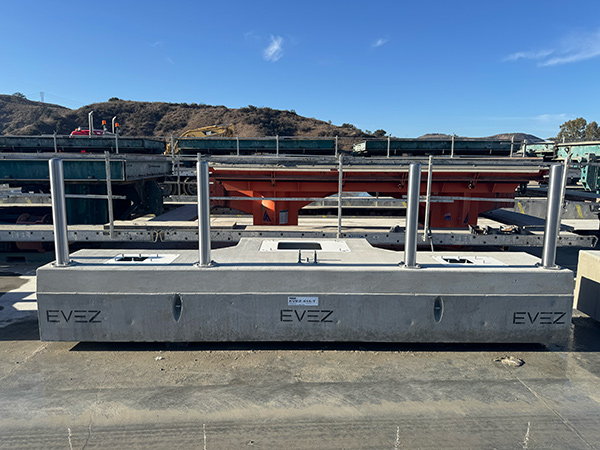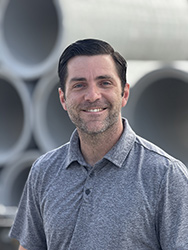Alleviating job site complexities and accelerating installation time for EV charging stations
By Jon Brantingham
As the number of electric vehicles (EVs) in the U.S. soars, with projections reaching 78.5 million by 2035, the charging infrastructure must keep pace. By 2035, we will need approximately 42.2 million charging ports – four for every person in America. Traditional cast-in-place concrete foundations are too slow and complex for this scale of deployment. One direction for streamlining the process lies in using precast concrete for EV charger foundations that can reduce installation from weeks to days. With states and the federal government now investing billions in charging infrastructure and streamlining approval processes, companies that can install chargers faster will capture more funding and generate revenue sooner.
For EV infrastructure companies, engineering firms and construction crews, every EV charging site presents the same challenge: how to mount chargers to the ground safely and durably. Each site requires custom engineering for unique seismic, wind, and soil conditions, followed by unique permitting and approval processes. Cast-in-place concrete slabs demand extensive labor constructing forms, building rebar cages, pouring and finishing concrete, waiting 7-28 days for curing depending on weather and mix design, and stripping forms. Weather delays are inevitable; concrete curing stops below 40°F and accelerates dangerously above 90°F, forcing schedule buffers that compound across multi-charger sites.
The process requires coordination between multiple trades, including concrete contractors, electricians, and inspectors, each dependent on the previous stage completing successfully. It also generates significant waste during pouring and formwork. When charging pedestals require replacements or upgrades, crews must re-engineer and pour new foundations, repeating the entire cycle. For a 50-charger site, cast-in-place could easily eat up weeks of foundation work alone, weather permitting.

Precast concrete foundations, manufactured in controlled offsite facilities, eliminate weather dependency and accelerate installation. Precon Products, a 60-year veteran in the precast concrete industry, collaborated with contractors and industry experts to develop EVEZ – a universal yet customizable precast concrete foundation system for EV chargers. The system includes integrated bollards for protection and is compatible with all major charger brands through a patented aluminum adapter plate system.
EVEZ reduces installation to four steps: site preparation and grading, setting the precast base with a crane or forklift, feeding cables through pre-made conduit knockouts, and bolting the charger to the foundation. No concrete trucks, no waiting for cures, no weather delays. What took 6-8 weeks now takes 3-5 days. Precon secured a patent for EVEZ in December 2024, protecting its adapter plate innovation that allows any charger model to mount to a standardized base.
The engineering happens once, in the manufacturing facility, where consistent quality control ensures each foundation meets seismic and wind load requirements. Each EVEZ unit weighs approximately 8,000-12,000 pounds depending on charger specifications, ships on standard flatbed trucks, and can be installed by a two-person crew with basic equipment.
Greenlane Infrastructure’s Colton site demonstrates the time compression precast enables: the project required installation of 50 charger foundations before the end of the year to stay on schedule. Cast-in-place concrete introduced schedule risk they couldn’t accept: weather delays compound, cure times require minimum 7-10 days even in ideal conditions, and every week of slippage costs thousands in staged equipment and idle crews. A traditional schedule would have required starting foundation work in early October, risking December rain delays.
Instead, Precon manufactured foundations offsite during permit and site prep phases, running engineering, procurement, and quality control in parallel with site development rather than sequentially. When Mortenson broke ground, foundations arrived ready to install. The 50 foundations were set in 5 days. The site energized in January 2025 and opened in April with 41 chargers now serving the I-15 freight corridor between Los Angeles and Las Vegas.
The cost comparison favors precast at scale. While individual EVEZ units cost more per foundation than raw concrete materials, the total installed cost runs 15-25% lower when accounting for reduced labor hours, eliminated weather delays, faster revenue generation, and avoided schedule penalties. Sites that would have required 8 weeks of prevailing wage concrete labor instead need one week of installation crew time.
The business case for faster installation strengthens as funding opportunities expand. California’s half-billion-dollar INVEST CLEAN Program and the federal government’s $5 billion National Electric Vehicle Infrastructure (NEVI) program are pushing billions into charging infrastructure. The August 2025 NEVI guidance update dramatically reduced bureaucratic overhead, requiring only fund usage plans, community engagement reports, and cybersecurity strategies. Corridors can now be certified as “fully built out” more easily, allowing deployment beyond Alternative Fuel Corridors. These changes strip away red tape while maintaining program fundamentals, accelerating deployment schedules.
Private sector investment is responding to the streamlined approval process. Hyundai Motor Group announced $21 billion in U.S. investment from 2025-2028, including $6 billion for energy infrastructure including EV charging. Companies that can install chargers faster capture more of this funding and generate revenue sooner. Every week saved in construction translates directly to earlier cash flow.
The growing demand for EVs makes efficient charging infrastructure not just a convenience, but a necessity. Innovations like EVEZ convert foundation work from a critical path constraint to a solved logistics problem, ensuring that as more drivers choose EVs, the infrastructure is ready to support them.

About the Author:
Jon Brantingham is with Precon Products’ electric vehicle charging department
From tradition to transformation Sequoia Brass & Copper has stood for excellence in American manufacturing. In this episode, we sit down with Kim MacFarlane, President of Sequoia Brass & Copper, to hear the inspiring story of a family-owned company founded by her father, built on craftsmanship, trust, and a relentless commitment to quality. Kim shares how she’s guided the company through the challenges of modern industry while honoring its heritage, and how the next chapter will be carried forward by her son Kyle. This is more than a story of brass and copper; it’s about resilience, innovation, and the enduring strength of family legacy. If you’ve ever wondered how tradition can meet the demands of today’s industry hit play and be inspired.